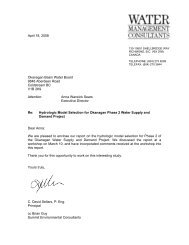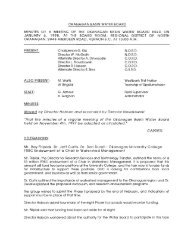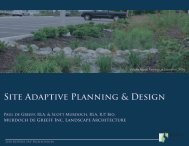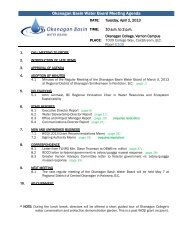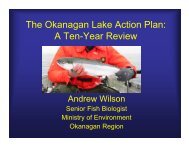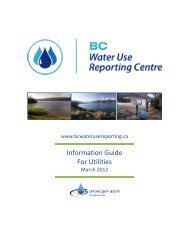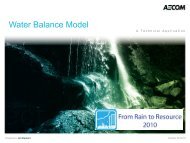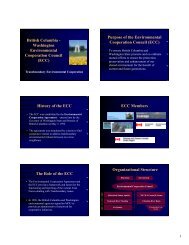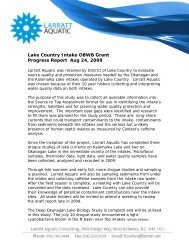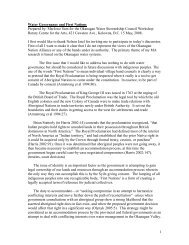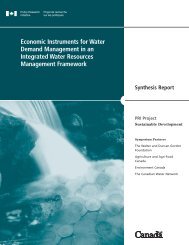Instream Flow Needs Analysis - Okanagan Basin Water Board
Instream Flow Needs Analysis - Okanagan Basin Water Board
Instream Flow Needs Analysis - Okanagan Basin Water Board
- No tags were found...
Create successful ePaper yourself
Turn your PDF publications into a flip-book with our unique Google optimized e-Paper software.
FINAL<strong>Okanagan</strong> <strong>Basin</strong> <strong>Instream</strong> <strong>Flow</strong> <strong>Needs</strong>A key concept worth keeping in mind when considering this question is resilience – thecapacity of an ecosystem to tolerate disturbances without collapsing into a qualitativelydifferent state that is controlled by a different set of processes. A resilient ecosystem canwithstand shocks and rebuild itself when necessary. As human development and waterextraction activities spread and become more homogeneous throughout the <strong>Okanagan</strong> basin,more and more pressures are exerted on fish populations. Land-use development that removesaccess to pristine productive habitats with BCIFN-like flows eliminates the refuge habitats thatfish populations would have historically inhabited when waiting out drought. Ultimately, thechoice of instream flows depends on: (i) ecological objectives (e.g., maintaining diverse,resilient communities vs. allowing sensitive species to be extirpated in favour of the hardiestorganisms, and accepting lower local diversity); (ii) personal value systems and (iii) the largerspatial strategic environmental management framework in place for fish protection in the<strong>Okanagan</strong>. For instance, one could choose to protect a number of representative, productive,pristine sub-basins as ecological reserves where human development and water extraction wereforbidden or highly constrained, and allow intensive development elsewhere. Were this thepresent situation in the <strong>Okanagan</strong> <strong>Basin</strong> (it is not) it might be possible for moreenvironmentalists to answer “yes” to this question.Q3: In the summer dry period, meta-analysis flows look like they’re actually enhancement flows,right?”A: Yes. If there were more water available during these periods, we would expect rearing salmonidspecies to benefit (i.e., achieve closer to optimal production at these times). Extraction activitieswill only further exacerbate the natural stresses to these populations. Our analysis shows thatfor a number of sub-basins, fish populations are already under stress due to the semi-aridclimate regime and hydrology in the <strong>Okanagan</strong> <strong>Basin</strong>.Q4: During the winter/summer dry weeks of the year, it looks like there’s no water at all left toallocate in fish bearing streams. From a fish standpoint, is this true? Doesn’t this mean we haveto add new storage in order to consider allowing further water allocations in these streams?”A: Our analysis shows that for a number of sub-basin systems, a variety of fish populations arealready under stress due to the semi-arid climate regime and hydrology in the <strong>Okanagan</strong> <strong>Basin</strong>.Therefore, yes, in many cases further water extraction activities will further exacerbate stress tothese populations. As one proceeds below these thresholds the likelihood of flow-relatedconstraints on aquatic productivity increases. The BCIFN minimum risk thresholds indicatewhen it is inadvisable (from a fish perspective) to remove flow but also indicate the times andamounts of flow that can be safely diverted when water is plentiful. Adding new water storageis one possible response to enable water extraction and meet instream flow needs, so long as therule-curves and operating procedures for these reservoirs do in fact explicitly take instreamflow needs into account. This includes the spawning period when reservoir releases may tend tobe lower than natural flows. The flow thresholds herein may help increase priority for studyeffort toward the collection of relevant data to resolve conflicts between proposed water usesand instream flows for fish (e.g., site-specific detailed assessments).Q5: Why does the BCIFN minimum risk method move in monthly time-steps when thefundamental time-step of the <strong>Okanagan</strong> water supply/demand study is weekly?”A: The BCFIN method is designed to develop recommended monthly (not weekly) flow thresholdsbased on variable percentiles of flow for each month based on daily flow data collected over a20+ year time period. For the <strong>Okanagan</strong> study we are limited to estimates of naturalized weeklyflows (some with considerable uncertainty) over a shorter 11 year period. Althoughconceptually the BCIFN approach could be adapted to be expressed as a weekly value an 11-yrxiESSA Technologies Ltd. &Solander Ecological Research



